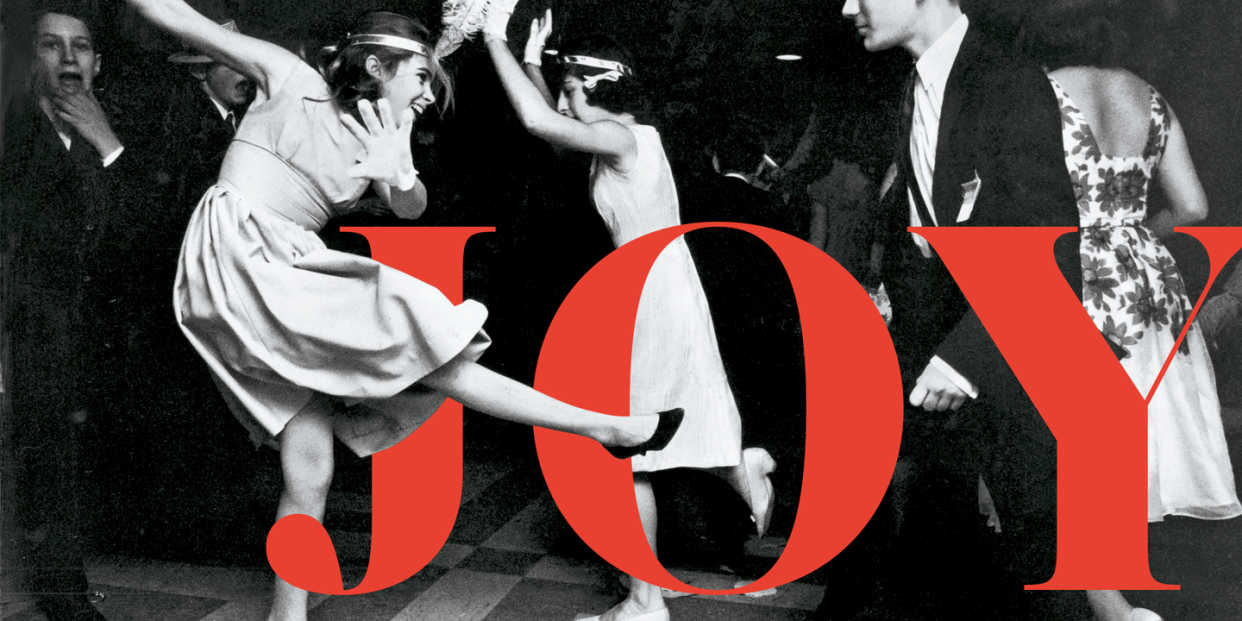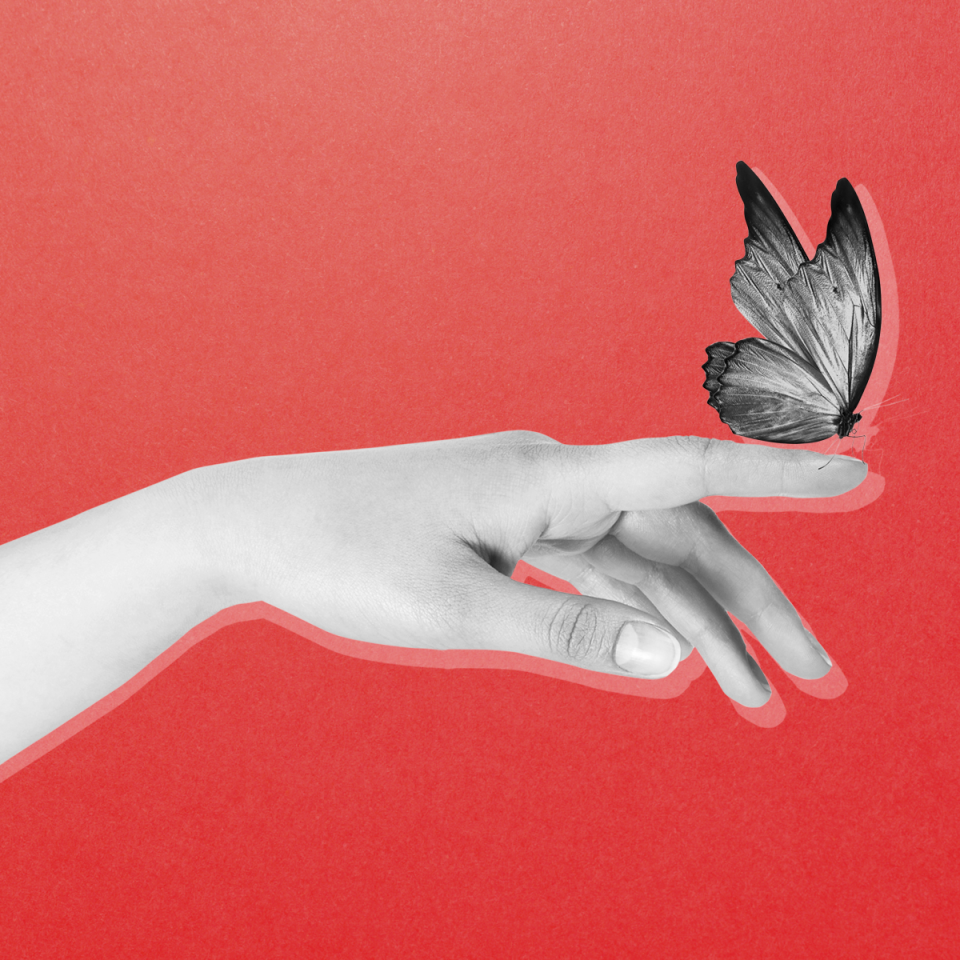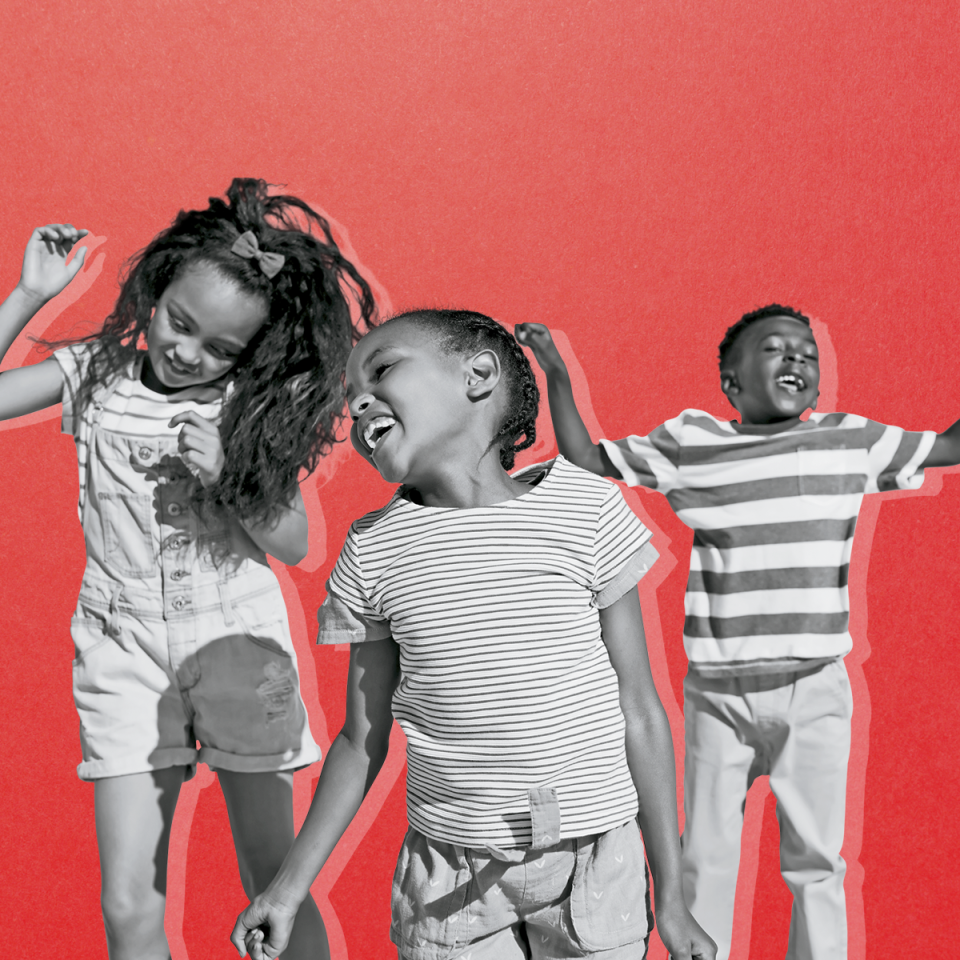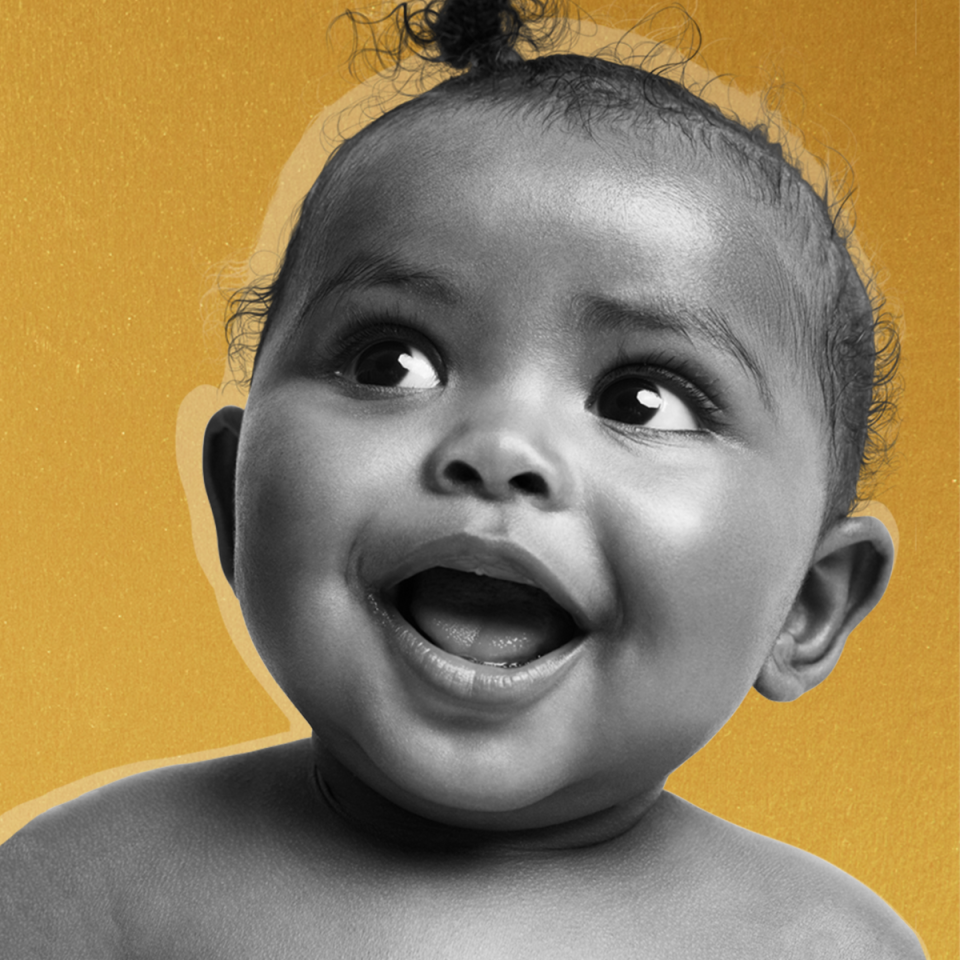Proven Tips and Advice on How to Cultivate More Joy in Your Life

- Oops!Something went wrong.Please try again later.
In this season of jolly, when we expect to find joy around every pine-scented corner, can we pause for a moment to ask: What, really, is joy? Why don’t we always feel it when we think we should? And how can we get better at sparking it all year long? To find out, Oprah Daily reached out to scientists and psychologists to see what the research has to say. Then we asked people who seem skilled at finding joy in everyday situations—including a comedian, journalists, activists, celebs, and other thought leaders—to share their wisdom. Read on for their advice and proven tips on how to cultivate more joy in your life.
The Science of Joy
By Jessica Torres Cooper

Imagine this: You’re walking along a path in your favorite park when a butterfly suddenly flutters past. You stop to observe its magnificent colors, the curvature of its wings, and the velvety surface of its skin. To your surprise, it lands on your hand. You delight in mutually observing each other, and a profound feeling of well-being and satisfaction moves through you. What is that feeling? Is it joy? Is it happiness? Scientists are currently investigating the difference between the two. To understand the distinction and why it matters, we spoke with experts about what joy is and how we can cultivate it beyond the holiday season.
While joy and happiness are both positive expressions, they are not one and the same. Happiness is a state of mind and well-being that can be modified by external events. Think of kids excitedly playing with their just-opened holiday gifts—until a new distraction catches their attention. Joy, on the other hand, can be thought of as a feeling that is spontaneous and often involuntary, but richer and more meaningful than happiness. The intensity of the emotion we feel when we experience joy comes from an inner connection to what we value and a presence in the moment to appreciate it. It’s the soul-settling awe, for example, of looking around a room and realizing how grateful you are for the people celebrating the holiday with you
Until relatively recently, experts rarely homed in on the nuances of this mysterious emotion. “Joy is ineffable. It is not easy to talk about,” says George E. Vaillant, MD, a professor of psychiatry at Harvard Medical School. “It can feel too intense, too private for others. The Victorians felt that way about sexual excitement. That is why social scientists and economists love happiness. Happiness is tame. Joy is laughing from the gut and weeping with joy. Happiness displaces pain. Joy encompasses pain.”
For the past few decades, psychologists, psychiatrists, and other researchers at leading universities have gathered and analyzed data to pinpoint exactly what defines joy. They don’t always agree on the definition and often use terms like joy, bliss, and happiness interchangeably in their work. However, The American Psychological Association Dictionary of Psychology classifies joy into two distinct types: “passive joy,” encompassing tranquility and contentment, like being alone in nature; and the more expressive “active joy,” associated with engagement and the desire to share one’s feelings with others. The latter feeling can often be intense, including pleasure, delight, and contentment to varying degrees.
Where most scientists do align is on how joy benefits us. It’s been found that joy not only contributes to good health and longevity but, like gratitude, can also bind us to one another. Our brains are hardwired with a motivational system that reinforces human connection, empathy, and attachment. And one of the keys to this system is joy.
Ultimately, joy can lead us to make personal connections, strengthen our family bonds, and grow our community. For instance, babies are programmed to respond with an irresistible joyous smile when making eye contact with their caregiver. Such social responses are evoked by and, in turn, produce mutual joy.
Communal joy also has evolutionary value. If early humans did not band together, they may have perished. Explains Vaillant, “The limbic system—the part of our brain that’s linked to behavior and emotion—helps facilitate strong attachment. Relationships, loyalty, and communal bonding were enormously helpful to our ancestors.” He goes on to say that whereas “happiness and excitement speed up the heart, joy and cuddling slow the heart down, reducing levels of cortisol, all of which produces a calm feeling.”
“Joy is a connection to the universe—connecting us with others. It is about relationships. You can be happy by yourself, but it would be hard to feel joy on a desert island,” says Vaillant.
Laugh A Lot
One of the many ways joy (and our brain chemistry) brings people together is through laughter, which releases a feel-good cocktail of hormones. “We release endorphins, giving us a feeling similar to a runner’s high,” says Jennifer Aaker, PhD, a behavioral scientist and chaired professor at Stanford Graduate School of Business. “We lower our cortisol, making us feel calmer. And these shifts in our brain impact not just how we see ourselves and how we behave, but how others see us and how they behave.
“Joy is not a happy accident, but a choice we make,” Aaker continues. “It’s about being more generous with your laughter and finding delightful moments in the day. When you don’t take yourself too seriously, you laugh effortlessly. And that is when joy flows.”
“In essence, humor paves the way for friendship and connection. It turns out that people who laugh together before having a conversation end up connecting in ways that feel 30 percent more intimate and authentic,” says Aaker. Not only are these connections crucial to forming strong community bonds, they can also have a lasting impact on our physical health.
Embrace The Calm
Loving relationships and a positive outlook protect us from mental and physical decline and are better predictors of longevity and a happy life than social class, IQ, or even genes, says the Harvard Study of Adult Development, which tracked participant health data for nearly 80 years. Other research indicates that joy can activate the parasympathetic nervous system, the part of our body that remains active when we’re at rest but that also leads to us feeling calm and relaxed. Activation of the parasympathetic system has been shown to buffer stress, lower pulse rate, promote digestion, and enhance memory.“Joy, like any positive emotion, can contribute to living a good life,” explains cognitive scientist Laurie Santos, PhD, a professor of psychology at Yale University. “Experiencing a more positive mood can improve things like your immune function.”
Schedule Merry Moments
You may be thinking, If the secret to aging well is joy, then great, I’ll spend all of my time doing what feels good! Easier said than done, since what truly brings joy may be more elusive than you’d expect. The reason is that humans can get used to gratifying experiences rather quickly—think of the decline in pleasure one feels after the first bite of a brownie or after purchasing a big-ticket item. Once the novelty has worn off, we no longer draw the same bliss we once did. “When we pursue happiness—and think we’ve attained it—its meaning shifts,” Aaker says, and we return to our previous level of emotion and start the pursuit again.
Psychologists call this phenomenon “hedonic adaptation,” or one’s innate ability to return to a personal, preset level of happiness no matter how life-changing an event has been. Luckily, there are still ways to cultivate ongoing moments of joy, and it starts with awareness. By recognizing that we have a natural tendency to balance out intense emotions, we can choose activities, such as hobbies, journaling, and volunteering to help others, that may alter our joy and happiness baseline.
It turns out that joy is complex but not impossible to find. Most important, once we do find it, joy is something we can unwrap throughout the year.
CHOOSING Joy
By Aida Rodriguez

When I was a kid growing up in Miami’s inner city, we played a game called the Dozens, also known as roasting, cracking, or snapping. The aim was to poke fun at someone else in front of an audience. Nothing was off-limits—not a dead relative, not illness, not even poverty. Whoever got the most laughs won.
While most suburban kids were going to soccer practice after school, I was roasting my friends walking home in the scorching heat. See, we didn’t have the resources to deal with our pain and problems. We had to find joy in our circumstances, and I found it by making others laugh. Laughter became my currency, and I went on to establish a career in professional stand-up comedy. I have my childhood and the sport of roasting to thank for helping me develop a skill set for riffing, along with a very thick skin. My friends often ask, “Yo, how do you always see the silver lining in messed-up situations?” The answer is simple: Joy is always the better option. It’s a choice you make, and sometimes choosing joy is the harder choice.
For me, growing up poor and in the midst of violence, laughing at the tough stuff often allowed me to keep going. I’d have been a wreck if I were constantly down every time something bad happened. Something was always happening!
Today I feel joy when I know others are laughing because of how I’m using my words, no different than those brutal summers on the block. I can close my eyes while onstage and see every single kid I grew up with cackling at the audacity of my mouth. Back then, I knew people were laughing at the things I was saying, but I was unaware of what was happening on a subconscious level: I was healing through connection with others. I was choosing to see joy everywhere and didn’t even know it. And that could only be good.
These days, when I’m not onstage, I spend time with my niece at the playground or volunteering at retirement homes. I feel deep joy for all the everyday people who make me laugh, but grandmas and babies are truly my jam. Human beings feel so perfect when they get here or are about to leave. It’s somewhere in the middle where things get a little messy.
Being able to brush off anything and move along in my own bliss is a gift. No matter how others may view where I came from, I will always be thankful to my hood for my quick wit and my unwavering superpower to call it all joy.
Check out Rodriguez’s one-hour comedy special, Fighting Words on HBO Max.
REDEFINING Joy
By Gayle King

Children have always brought me joy—which is part of the reason why I’d always known I wanted my own. Fun fact: By the time I was in the seventh grade, I’d already picked out placeholder names for my future children: Rusty and Dusty. Twenty years later, when I found out I was expecting my first child, I honestly really wanted a boy. Mostly because as the eldest of four girls, I’d always dreamed of having a big brother. So, when my favorite daughter, Kirby, arrived, I immediately thought, Well, this isn’t quite what I had planned. The point is: We tend to think that joy only comes in the form of momentous life events—like, say, having a child—and that all those big days add up to one joyous ball.
But as I got older, I began to realize that it’s not the bells and whistles that bring me joy. Instead, it’s the little, daily things, like when my daughter and son (yes, I did finally have a son) were kids and I’d catch their last smile at bedtime and their first one in the morning. There was no other feeling like it.
These days, the joys come in even smaller doses, like when I get a negative coronavirus test. I feel a sense of joy, not to mention deep relief. I even feel joy when the dentist calls to cancel my appointment. (If you know me at all, you know that I’m terrified, with a capital T, of the dentist.) Knowing that I have good health is 100 percent more important than ever.
Another thing that fills me with joy? Seeing someone else’s dream come to life—whether that’s being accepted to the college of their first choice, or landing an ideal job, getting cast in a knockout movie role, or just receiving a really good birthday gift. Those moments never fail to lift me up.
Bottom line: Sure, I may be a lifelong member of Team Glass Half Full, but joy doesn’t have to be something big and life-changing. In fact, I challenge you to take a page from my playbook and discover the little things that’ll bring you joy each and every day.
It’s the Little Things!
These notable women have big careers and have won big awards, but the things that bring them the most bliss are the everyday delights we can all enjoy.
Take the Leap

The PURSUIT of Joy
As lead national correspondent for CBS Mornings, David Begnaud has covered major news stories around the world, including the shooting at Pulse Night club in Orlando, Florida; the terrorist attack at the Inland Regional Center in San Bernardino, California; and the catastrophic effects of Hurricane Maria in Puerto Rico. In the midst of many dark scenes, he’s been awed to witness the dawning of deep, poignant joy. “I often meet individuals in their most vulnerable moments,” says Begnaud. “Yet even in those trying times, I’ve seen people reflect on their lives with gratitude. Those reflections then lead to a warm and hopeful feeling within that person. So I’ve learned that joy can suddenly creep into your life just like [negative emotions] can.”
He’s also learned that you don’t have to wait for joy to find you— if you go looking for it, there it is in the most unassuming places. “For me, joy comes in many forms: I will be flying around the country, exhausted, wishing I were back home. Then, in an instant, I can have a moment of awareness—a self-reminder, really—that I’m doing what I always dreamed of doing in my life.
“Finding healthy food to eat while on the road is another thing that brings me joy. My workdays can be 18 hours long, so a great, fresh meal goes a long way.
But my greatest feeling of joy occurs when I arrive home to my partner, Jeremy, and my dog, Paddington. Jeremy and I have been in a long-distance relationship since 2015, which is not easy. My life is lonely on the road, so seeing the two of them, which is usually only for one to two weeks a month, is something I look forward to very much. When the nose of the plane is headed home, I am a happy man.”
David Begnaud, Oprah Daily’s new Joy Ambassador, seeks out stories of hope to inspire you. Watch his premiere interview here, and look out for more stories to come.
You Might Also Like

